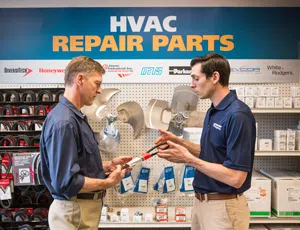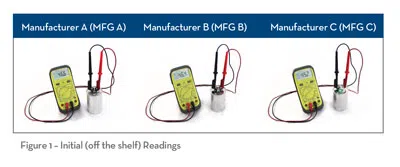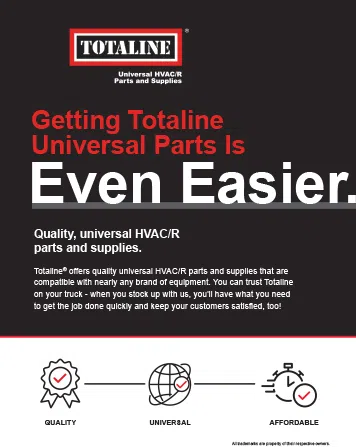There are several circumstances where universal parts are a smart choice.
When a customer calls to say their HVACR system isn’t working properly, contractors generally want three things: to know which parts they need, find them fast and have them work perfectly.
To get there, a technician who has made the decision to repair can take one of two routes — use parts that come from an Original Equipment Manufacturer (OEM) or use universal parts from a different manufacturer. There are a few factors to consider when deciding which route to take:
Price. Price is one of the most important factors. Universal parts often cost 25 to 60 percent less than OEM parts. Over time, that adds up to a substantial amount of money back in your pocket.
Warranty. The contractor should check if the system is under a manufacturer’s warranty. Depending on the terms of the warranty, the contractor may be required to use OEM parts.
Quality. It’s no secret that not all repair parts are created equal, and the last thing you want is a customer calling you soon after the repair to say their system has failed again. However, in many cases, the universal part is just as effective as their OEM counterparts — you just need to examine the source.
Time. Performing the necessary research to ensure that a part is of good quality and is compatible with your customer’s HVAC system takes valuable time. Contractors also need to consider the time it takes for an OEM or universal part to arrive.
In the interest of saving time and peace of mind, contractors often go straight to OEM repair parts. However, there are several circumstances where universal parts are a smart choice. Instead of dedicating company resources to assess the quality and price of repair part options, many contractors are relying on their distributors — who have the inside knowledge and vetting capabilities — to make recommendations based on each situation.
For example, Ferguson HVAC stocks both OEM and universal aftermarket parts, and they maintain strict quality standards that all manufacturers must meet before carrying their products. They also have software that enables their associates to quickly generate a list of all compatible parts available — both OEM and universal — on any model of equipment.
Partnering with your distributors to assess each scenario individually provides you with the opportunity to consistently find high-quality, cost-effective repair parts. Consider these scenarios:
Scenario 1
An afterhours service call has your technician out diagnosing a furnace that is not working. The technician diagnoses the run capacitor on the furnace blower has failed. Using a universal capacitor from a properly stocked truck, you should have this customer up and running and feeling comfortable shortly.
Recommendation: Universal parts
Rationale: The need to stock your service vans with duplicate items for the many brands of equipment is both costly and impractical. Your customers will appreciate getting the repair completed on the first trip, your technician will spend more time earning revenue for your service department and your back office will have less paperwork to track down a small warranty credit. In the case of capacitors, stocking and selling an EIA-456-A rated capacitor will set your company apart. The testing required to achieve this designation simulates a run time of 60,000 hours. This standard will allow you to garner a premium on the repair, and rest assured that you will not have a callback on a properly diagnosed failure.
Scenario 2
While performing your regular preventive maintenance check on a gas furnace, your technician correctly diagnoses and condemns a furnace with a cracked heat exchanger.
Recommendation: OEM parts
Rationale: Certain parts are available only from the Original Equipment Manufacturer. Items like a heat exchanger have a critical safety component that is a function of their engineering. Condenser coils, while perhaps not holding the same safety-critical function, would also need to come from the original manufacturer. Many distributors have relationships with more than one brand of equipment, making them of value to you in sourcing OEM parts. Maintaining a business relationship with dozens of distributors is time-consuming, so consider what efficiency can be gained by maintaining a service department relationship with a single, versatile equipment and parts distributor.
Scenario 3
Your technician finds that the furnace he is working on has a failed induced draft motor.
Recommendation: In the past? OEM. But today, go for aftermarket universal parts.
Rationale: Call an HVAC distributor who carries aftermarket induced draft motors. While there is no “universal” inducer motor, some distributors have the technology to identify the motor type and size you need to stock to fit thousands of models. Unlike a heat exchanger or condenser coil, the tooling required to build a motor is not indigenous to the original brand. In most cases, the aftermarket motor is the same exact motor as the OEM motor because of the vast amount of replication in the marketplace. In some cases, the aftermarket version can be a third of the price of the original motor.
Scenario 4
A defrost board has failed on an out-of-warranty heat pump.
Recommendation: Universal parts. Most of the time.
Rationale: There are multiple universal defrost boards available on the market. Some units require an OEM part, but most can be fixed with a universal replacement that is equal in quality but lower in cost.
Technicians are faced with new service challenges with every customer visit. Your distributor should be a knowledgeable resource who can help you make the right choice.
One last consideration technicians should consider is ensuring they have the proper installation training for which ever option they choose. You can overcome the confidence gap that holds many technicians back by training with a manufacturer and distributor. Your distributor should provide regular training classes in the slow season to keep you familiar with the newest repair parts on the market. By holding your supplier to these expectations, you and your customers will ultimately benefit.




